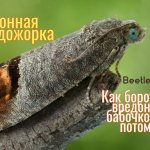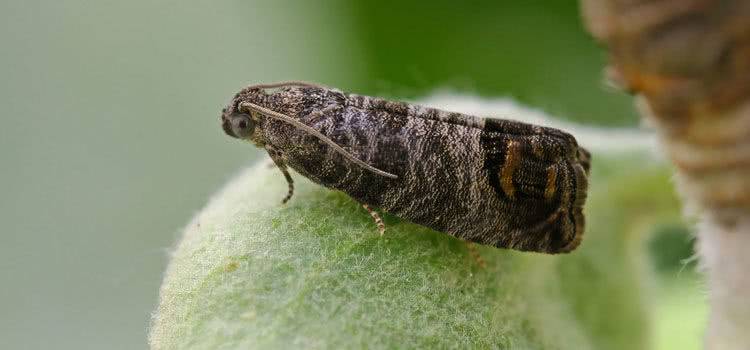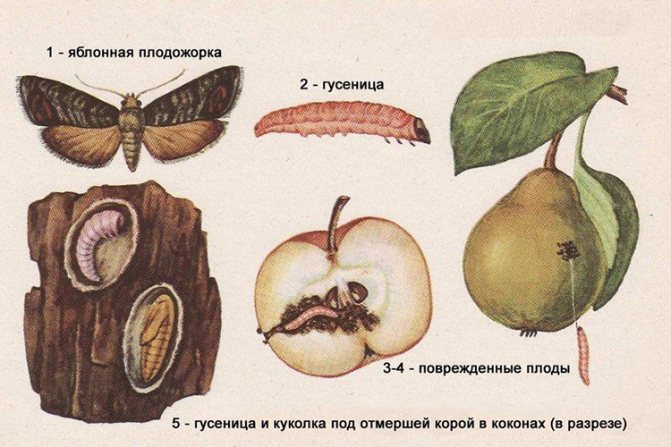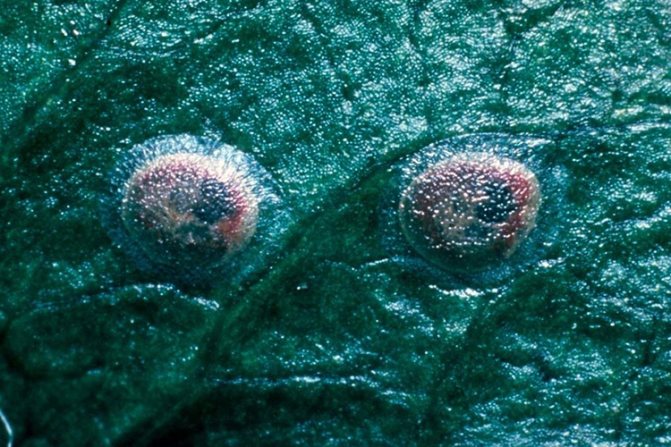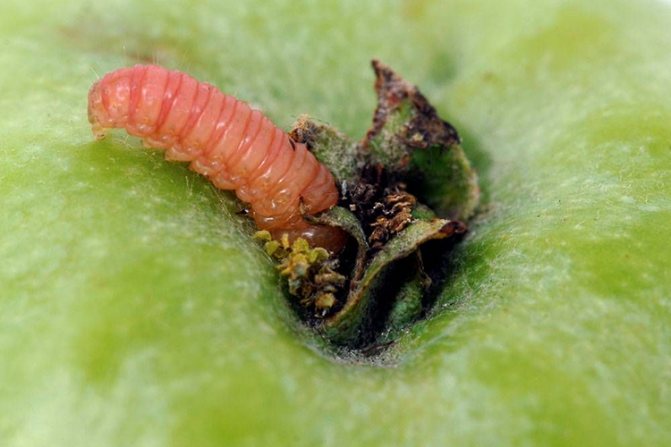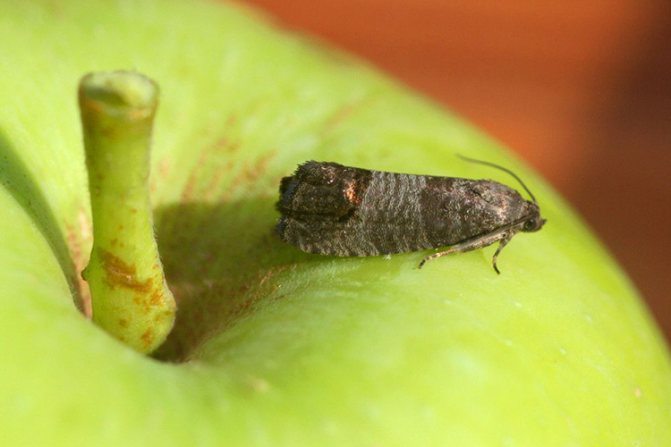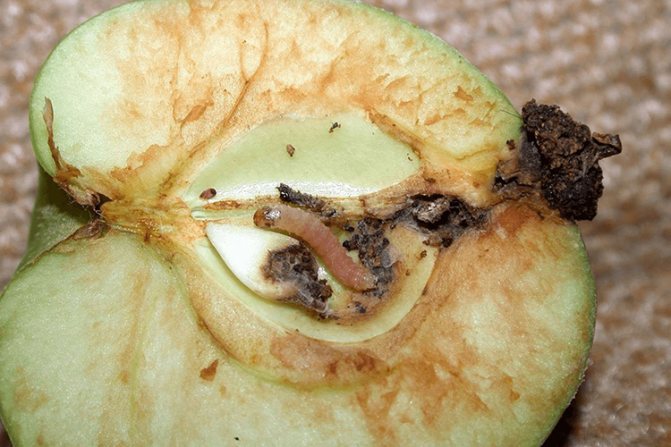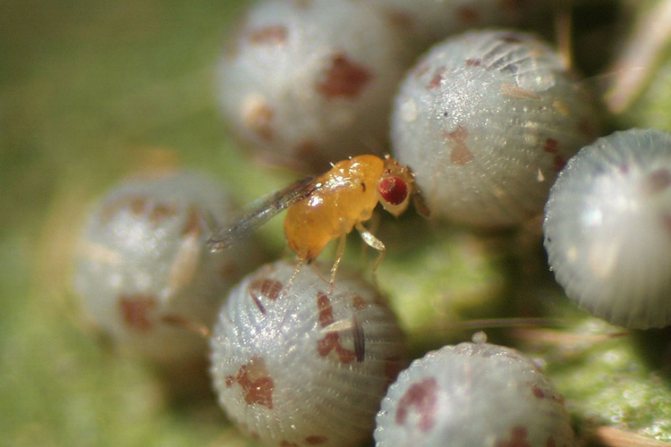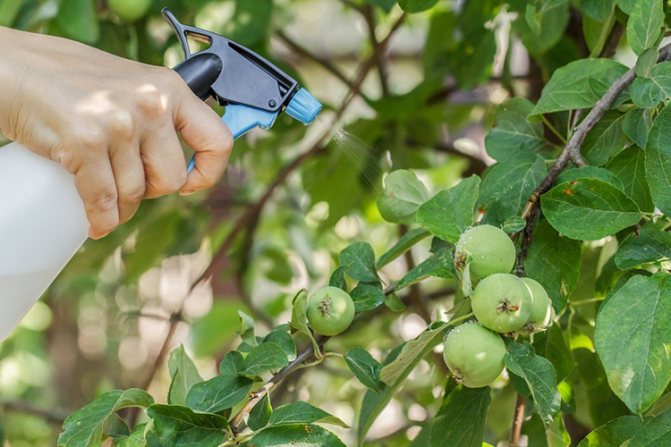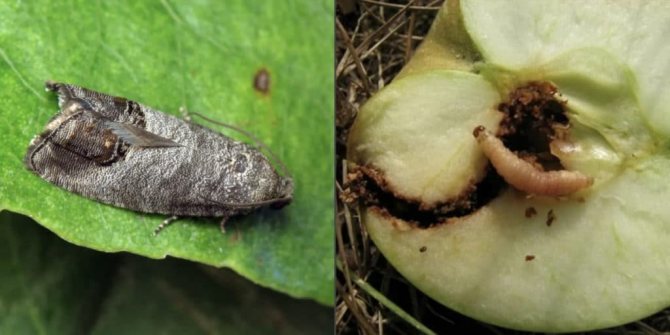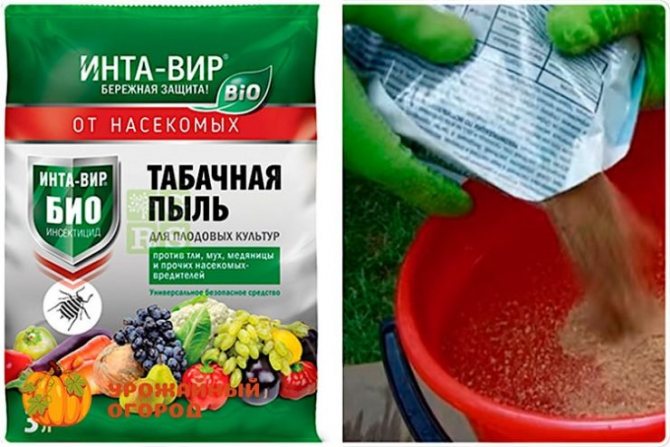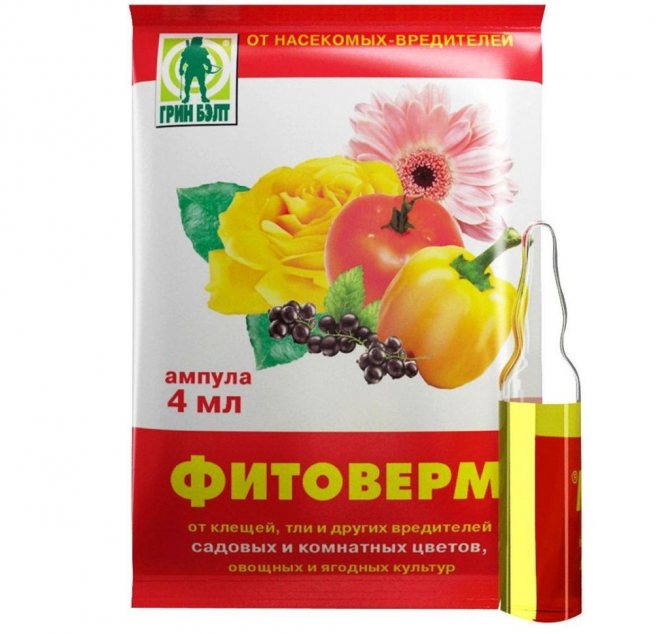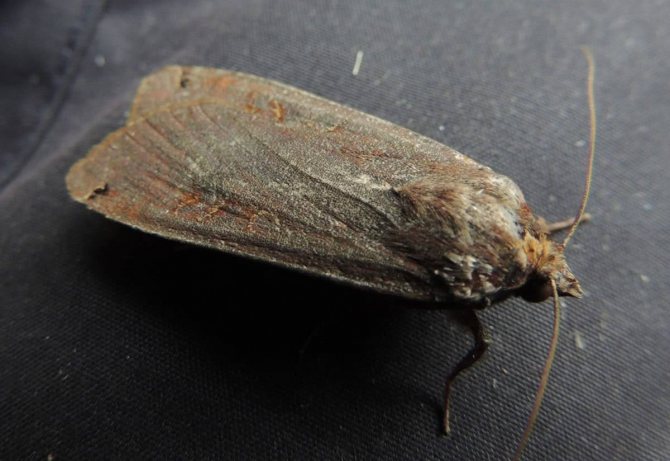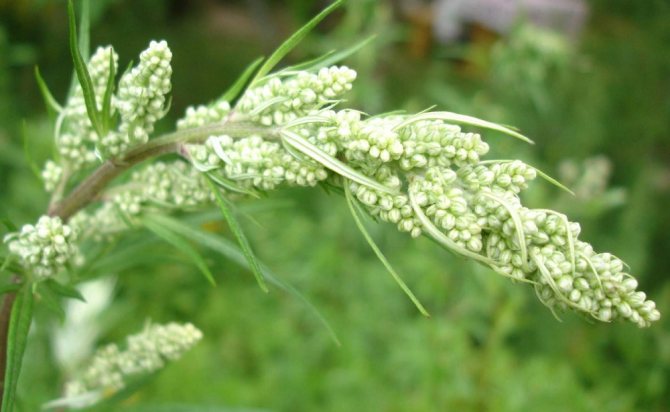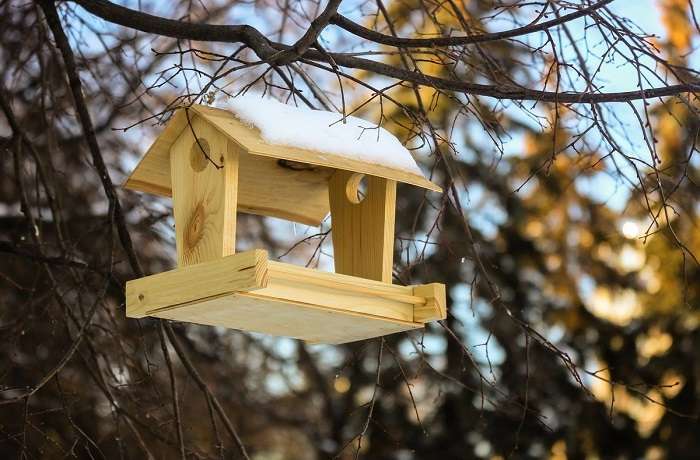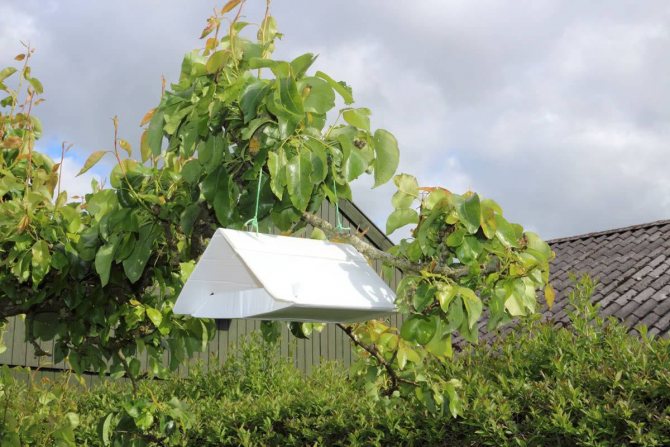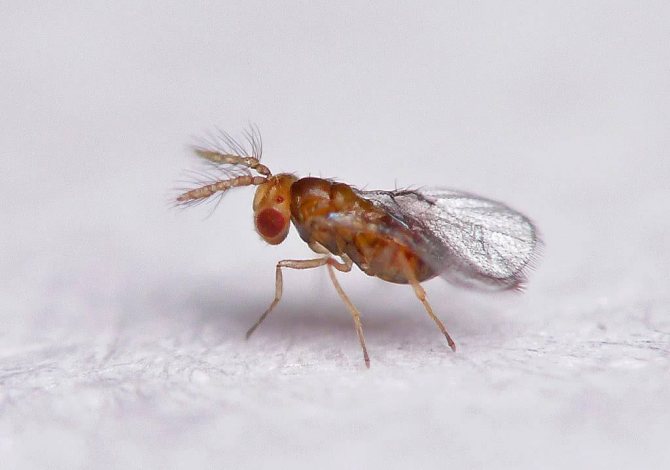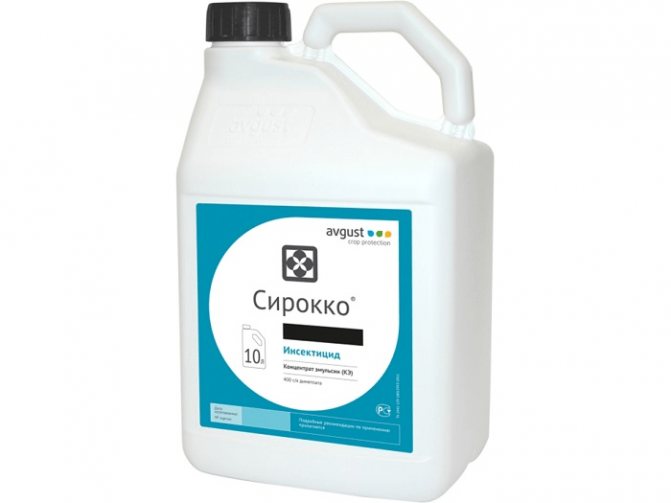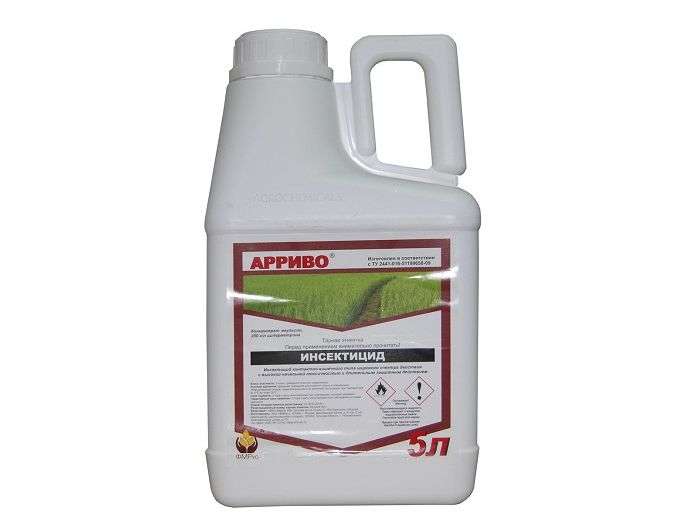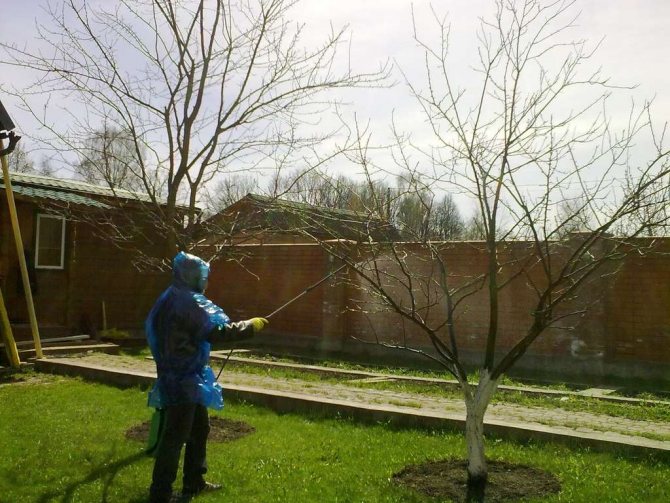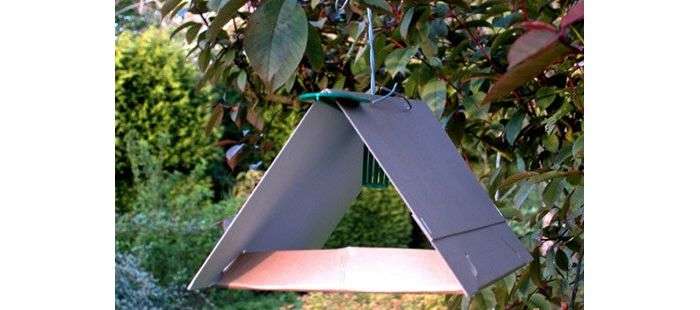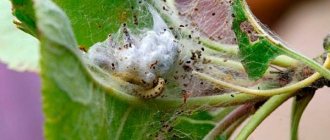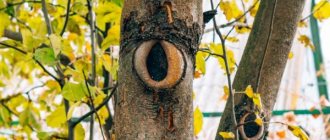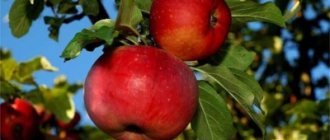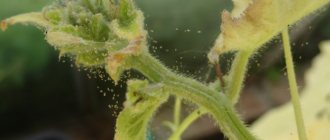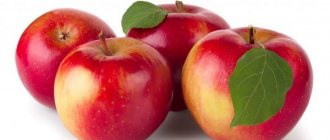The apple moth is one of the most famous and common pests. Its appearance is familiar not only to gardeners, but also to all fruit lovers. Surely, everyone at least once in his life found a worm in an apple. With a probability of 99.9%, it can be argued that it was a caterpillar of the apple moth. There are many ways to deal with a pest. But, in order for destructive and preventive measures to be effective, you should familiarize yourself with how the codling moth looks like and the features of its reproduction.
Symptoms and features of an insect
You can notice insects on the apple tree. Two weeks after the apple tree blooms, a lot of nondescript gray butterflies appear. Insects in the garden can also be spotted by small holes in the ovaries. Another sign that should alert you is a seemingly intact carrion, and inside it many moves have been made. The apple moth affects fruits at any stage of their development.
Eastern moth on an apple tree
This pest grows and develops very quickly. During the season, especially in warm regions, 5 generations can fully develop. Moreover, they do not disdain the neighborhood. 5-7 larvae can settle in one apple.
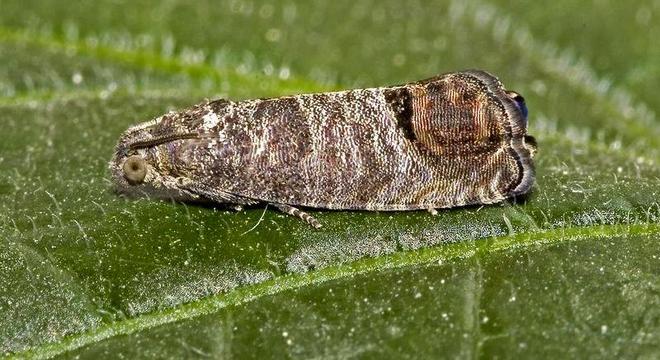
Eastern moth on an apple tree.
Spread
Almost the entire mainland is included in the zone of influence of the pest of horticultural crops. The exception is the tundra zone. But most often the moth appears in the steppe zone.
Influence of moisture on the pest
The moth is very fond of humid air. In conditions of prolonged dry temperatures, the pest quickly dies.
Caterpillar - what it is
Basically, a caterpillar is a small worm that is overweight. The body is most often pink or pale. There are no hairs or pubescence, but there are legs with claws that help to walk on fruits and make their way inside the fruits.


Caterpillar of the codling moth.
Pest life cycle
The apple moth has its own life cycle, which runs from laying offspring to the moment of finding a place for pupation. However, it is worth noting that all steps may differ slightly depending on the distribution region.
Number of generations
The number of offspring that one pest can give depends on the region. So:
- in the Northern region, two generations can grow per season;
- there are three generations in the southern regions;
- in the east, in the steppes of Ukraine and Crimea - up to five generations per season.
But these numbers can vary depending on the temperature indicators of the region during a particular season.
First generation
The first pests of the season were seen in May. But depending on the territory, they can start years at the beginning or end of the month.
Wintering stage
For the winter, moths of the second or even third generation pupate most often. They are conveniently placed in white cocoons and survive the cold season there.
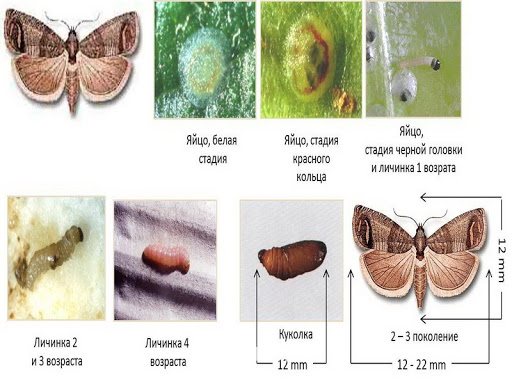

Pest development stages.
The appearance of the pest and its life cycle
In appearance, the butterfly is completely inconspicuous and it is rather difficult to notice it on the tree. An adult insect is 1 cm long, with a wingspan of 1.8-2 cm. The front wings are dark gray, with transverse dark wavy lines and a yellow-brown spot, the rear ones are light brown. The apple moth reproduces during the flowering of the tree, this period takes 1.5-2 months.1-3 days after emergence, the butterfly lays round greenish-white eggs 1 mm long on the shoots, leaves and set fruits. The activity is observed mainly in the evening. Each moth can lay 60 to 120 (maximum 180) eggs.
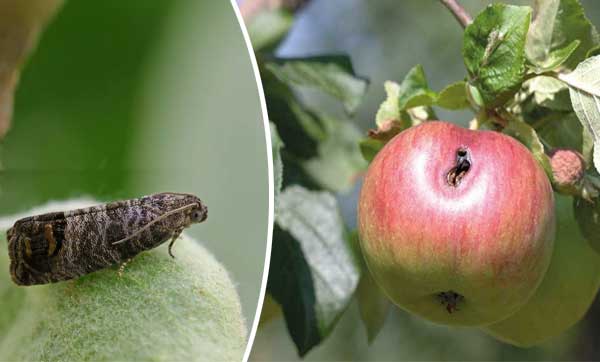

After 5-11 days, larvae emerge from them, flesh-pink above and yellowish-white below, with a brown head. It is the caterpillars of the codling moth that harm the fruit, they eat away the young ovaries, penetrate the apples, leaving holes in them. For 1 season, the pest can leave 1-3 generations (depending on the climate of the region), the second of which is the most dangerous for fruit trees. It destroys up to 80-90% of apples, while the first generation - about 25%. During the period of its development (22-45 days), each caterpillar can damage 1-2 pieces. From May to October, the pest can occur at all stages of its development.
After the end of reproduction, the codling moth goes under the bark or into the ground in the near-stem circle to a depth of 3 cm, where it remains in cocoons even in winter. Insects can hide under leaves and branches, in rooms with fruits, in containers. Pupation of the codling moth occurs in spring, at t 8-9˚C, butterflies start flying out in 2-3 weeks.
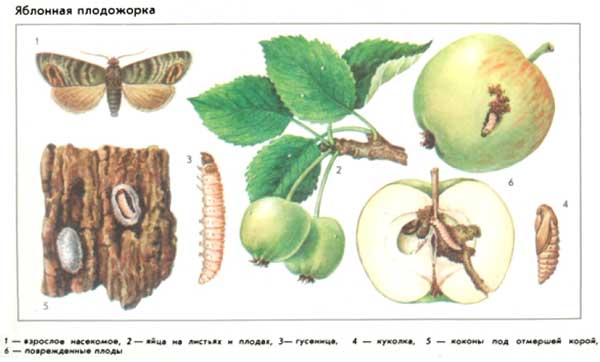

Fruit moth on an apple tree: methods of struggle
There are several ways to help defeat the insect. These include control measures such as chemicals that will help remove the pest, as well as a number of agronomic measures that will serve as a one-time prevention. A number of drugs will help to remove the eggs of the moth and adults from fruit crops.
It should be understood that the moth will not appear on the apple tree if the trees are cut on time, fed and with good immunity. You can try to create conditions for the moths to be as uncomfortable as possible.
What contributes to the survival of the butterfly
There are a number of factors that contribute to the fact that the butterfly is very difficult to remove from the site. The most common are:
- a large number of pests. In favorable times, many insects are born, and each of them, passing through the life cycle, harms fruits and gives birth to offspring;
- many secluded places for wintering. Caterpillars pupate for the winter in all possible secluded places: in cracks in the bark, compost heaps, fruit storage areas, containers.
These factors ensure the vitality of the moth and its large population.
Processing chemicals
There are a number of chemicals that can help protect your garden from moth attack. But all of them must be used correctly and in a timely manner so as not to harm beneficial insects and fruits.
Fitoverm
The drug based on aversectin acts in a complex manner. It penetrates into the insect through the skin and through eating the shells on which the poison remains. The animal's nervous system is paralyzed, and it dies.
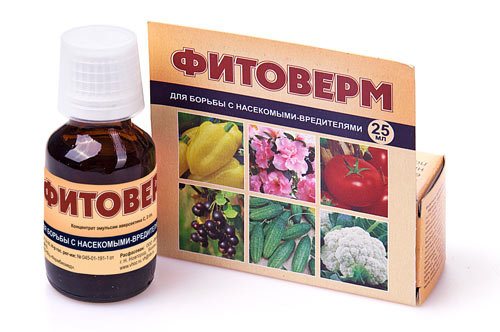

Fitoverm drug.
Herbicide
Herbicides should not be used for garden products, contrary to the assurances of some unreliable sellers. These drugs will do more harm to plants than harmful insects.


Herbicide Tornado 500.
Pesticides
All of these drugs act as insecticides. They get inside the caterpillar and hit it so that it cannot feed and dies. Among them: Taran, Confidor, Tanrek, Kinmiks, Sumi-alpha, Fastak, Karate-Zeon. However, it is very important to consider that these substances have a cumulative effect and cannot be used later than 30 days before harvest.
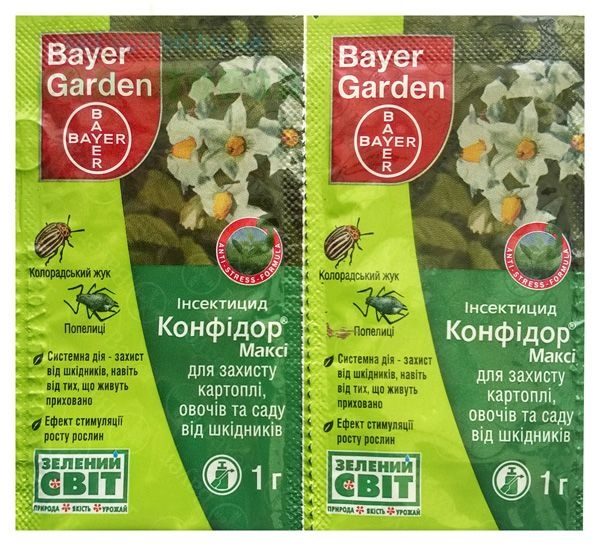

The drug Confidor.
Mixed insecticides
There are a number of poisons that give good results only when used in combination. They are also used when the same substances have been used several times in a row and are no longer as effective.
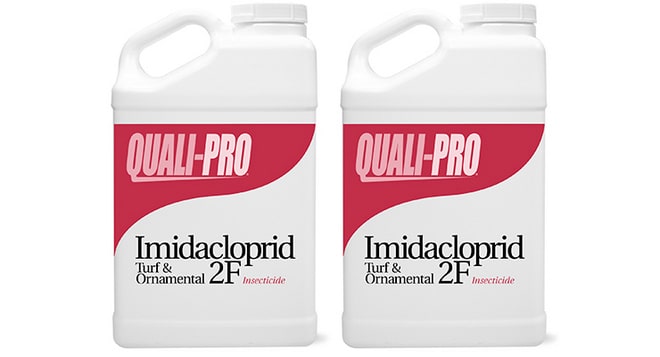

Mixed insecticide.
A mixture of Imidacloprid and Lambda-cyhalothrin or Thiamethoxam and Chlorantraniliprol has proven itself well.
Organophosphate insecticides
These are some of the most toxic chemicals that are most effective. The most common are Karbofos and Dichlorvos. The expense is small, the cost is quite loyal, and the efficiency is at the highest level.
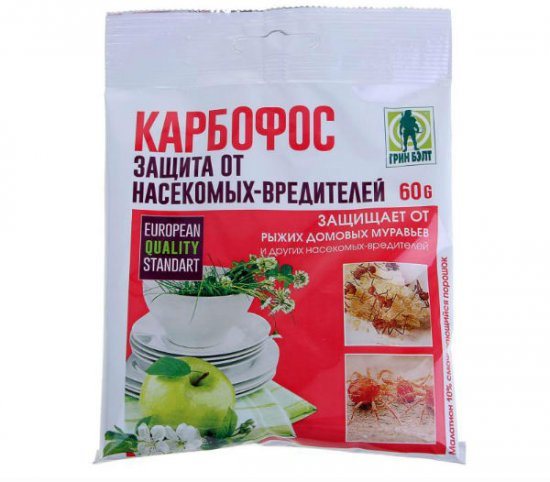

Organophosphate insecticide.
Why an insect is dangerous for an apple orchard
One pest during its life is capable of damaging from one to 2-3 fruits. Given their number (one butterfly can leave up to 130 eggs), garden culture can be doomed if the gardener does not fight insects. Under suitable positive conditions, the moth during the summer season can destroy up to 90% of the crop.
Another danger is associated with attracting other insects. The caterpillar gets inside the apple and promotes the formation of rot, which provokes wasps or bees to look for an attractive smell for them - not too pleasant neighbors for an untrained gardener.
Spraying technology
For spraying, special devices are used that produce small droplets. Like a fog, they fit densely on the green, thus, the consumption is less, and the efficiency is greater.
Spraying time
The exact dates cannot be named, because they can vary depending on the region, seasonality and climatic conditions. The term directly depends on the region.
In the spring
In the spring, the first treatment is carried out at the beginning of summer for adult butterflies. The most effective substances are organophosphates, which act not only on adults, but also on caterpillars during their birth.
After flowering
At this time, the most massive flight of butterflies is taking place, they are just hordes, so it is necessary to use poisons like Gerold, Dimilin and Insegar. They act on adults, and then the larvae hatch on the treated surface and also die.
During the period of fruit ripening
You can not use synthetic poisons during the ripening and harvesting of fruits. At this time, biological products, decoctions, trapping belts and traps are used.
Dates in autumn
In autumn, the garden is cleaned only after the leaves fall. All trash is removed and cleaned, the trunks are cleaned and whitened, the crowns are sprayed.
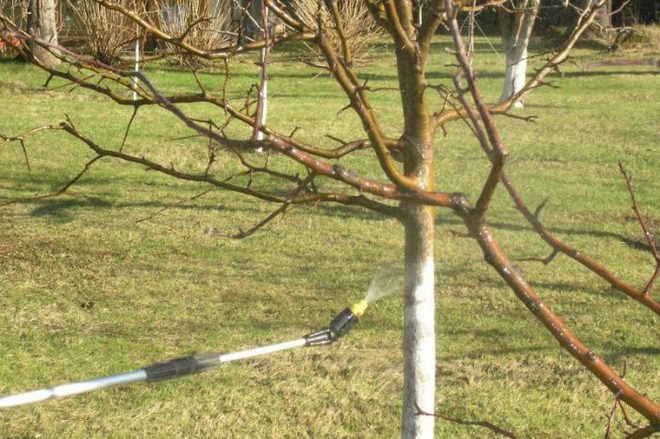

Spraying the apple tree.
How often to spray
The frequency of treatments depends on the region. After all, it is from the territory that the number of generations of pests changes in one season. In those regions where the moth gives two generations per season, summer varieties are sprayed twice, and winter varieties 3-4 times. In the same place where the moth breeds 3-4 generations per season, it will need to be sprayed twice as much.
Spraying terms in the regions
The southern part of Ukraine, the Volga region and the Stavropol Territory should be sprayed 10-12 days after the end of flowering. It will need to be repeated approximately in two weeks if there are caterpillars in the carrion.
In the Krasnodar Territory and the North Caucasus, the first time you need to spray 10 days after flowering, the second - after three weeks, and the third - after 15 days.
Environmental control methods
These methods include those in which the action is directed to the destruction of insects directly. Moreover, they are completely harmless to nature.
Pheromone traps
These are traps, the action of which is based on luring insects. But here there is one important nuance: they must be applied in a complex throughout the garden, and even better in neighboring areas too. Then their effectiveness will be felt. Traps placed alone will not have the desired effect.
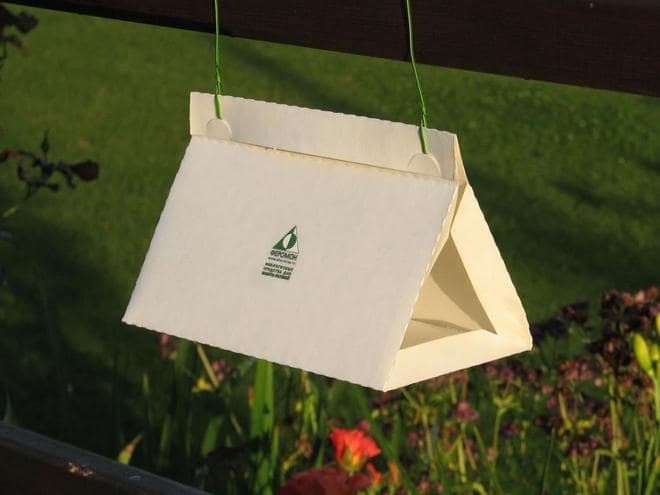

Using a pheromone trap.
Fighting the moth on an apple tree with folk remedies
The fight against the moth on an apple tree with folk remedies includes the use of decoctions, tinctures and physical cleaning of the trunk circle.For spraying, use a tincture of makhorka, a decoction of wormwood, tomato or potato tops.
Description of the codling moth


Apple moth is an insect related to the family of leafworms of the order Lepidoptera.
Outwardly, in an adult state, it is a small butterfly with gray wings, the lower ones of which are lighter and framed in the form of a fluffy fringe, and the upper ones are dark ash-colored and decorated at the ends with brown ovals with golden streaks.
Wingspan from 17 to 22 mm. They lay white, flattened eggs up to a millimeter in diameter.
Caterpillars are flesh-colored or slightly tea-colored, cream-colored, up to 2 cm long. The head and stripe of the occipital part are brown. Gray warts are scattered over the body.
The larva has a shiny light brown cocoon up to 1 cm long.
Methods without chemistry
There is a possibility of effective processing of apple trees from the moth without the use of potent chemicals.
Trapping belts
The creation of belts on the stem is one of the effective and proven ways to protect apple trees from the moth. Burlap or other dense fabric must be dipped in poison and wound. This must be done before the first flight. They are periodically examined and the insects are wiped out in liquid soap if they have been trained as trappers. And if they are conceived immediately for destruction, they are simply impregnated anew.
Glue composition
You can spread the belts with special glue, which is easy to prepare at home. To do this, you need to take 10 parts of resin, two parts of garden varnish, one and a half parts of rosin and paraffin. This mass is heated and stirred evenly until the state of the paste.
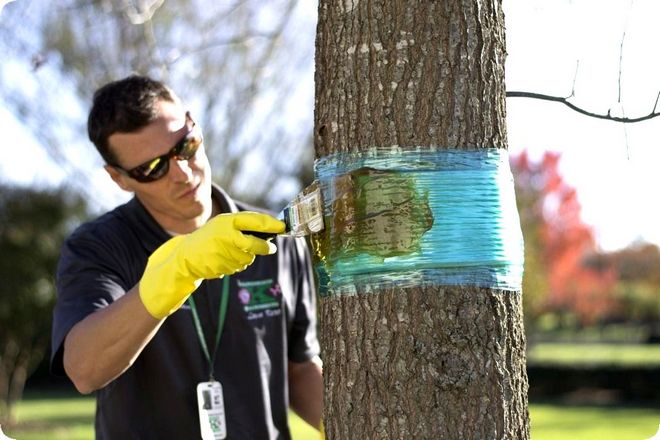

Applying glue to the trapping belt.
Another recipe for making a mixture for spreading trapping belts. You will need 450 grams of wax, 300 grams of rosin and about a liter of vegetable oil. The first components are gradually heated, and the oil is gradually introduced to make the mass sticky and plastic.
Integrated protection
This includes a set of actions that will help to minimize the number of moths on an apple tree, while reducing the number of caterpillars and butterflies on the site. These are agrotechnical, mechanical and physiological methods. Simply put - garden protection measures and pest prevention.
How to avoid re-infection
If the fight was resolved in favor of gardeners, then you need to protect the apple trees so that pests do not settle on it again. This is possible only if you carefully monitor the garden, do not allow the slightest appearance and manifestation of pests.
Preventive treatments
In the spring, gardeners always carry out important procedures - pruning and spraying. The use of chemicals in the spring will help protect the apple tree from the invasion of various types of pests, including the moth. Insecticides will kill juveniles that hibernate during the cold season.
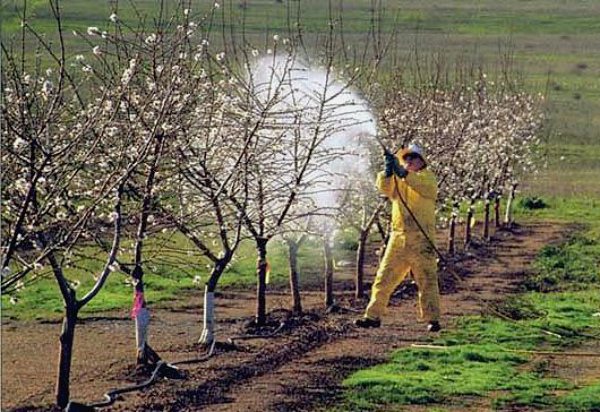

Preventive treatment of the apple orchard.
We plant resistant varieties
Although there are no apple varieties that are not at all exposed to the moth, immune species are much less susceptible to the negative influence of pests. It is important to choose varieties suitable for the climatic conditions of the area.
Pest control measures
Pests of tomato seedlings and control methods
When the moth appeared on the apple tree, the methods of control can be different. There are many options for dealing with a pest that can seriously damage your crop. According to the principle of influence on an insect, they can be divided into:
- chemical;
- agrotechnical;
- mechanical;
- biological.
Important to remember! Only a competent combination of each of them can lead to the complete destruction of the moth.
First of all, it should be understood that, depending on the care of the trees, the likelihood of damage to apple trees is determined.Those plants that are well-groomed, trimmed in time, fed in time, are able to resist the invasion of moth butterflies. But apple trees weakened in winter, which did not feed and cut on time, are most quickly affected.
Preventive methods of pest control
In order to start the fight against moth butterflies in a timely manner, you can independently track their numbers. Pheromone traps can help with this. They are placed in the garden and the number of butterflies caught per week is monitored. If their number exceeds 5 pieces, then more effective measures should be taken.
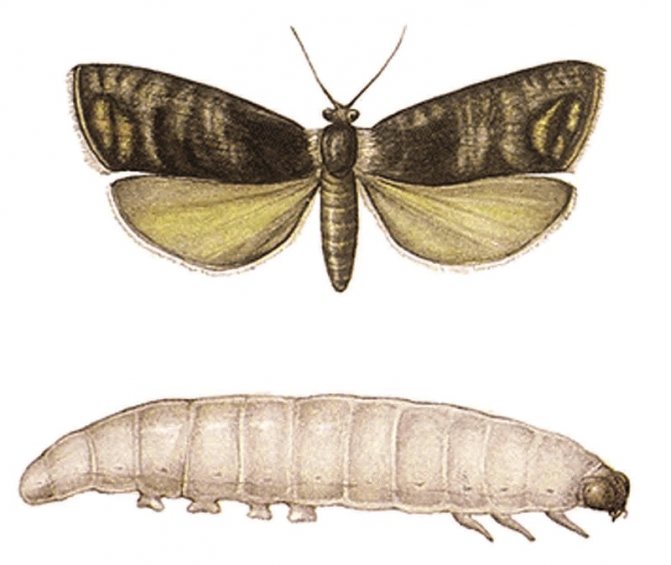

Male specimen
The principle of operation of such a trap is based on the action of female enzymes on males. The last ones appear the very first in the spring, they fly to the smell and fall into traps. So it will turn out to catch most of the males that they will not have time to fertilize the females. In the garden, one trap is enough for 5 trees.
Important! The effectiveness of these traps is very high. If you place such devices around the garden in a timely manner and in the required amount in the spring, then you can completely protect the apple trees from the invasion of many pests. Pheromone oils are completely safe for humans and animals.
You can buy ready-made traps, or you can make yourself. For manufacturing, you need a cardboard box that can be disassembled at the seams. The three sides of the box are fastened together with staples, forming a kind of prism. A hole is made at the top of the roof on each side, through which the two sides are connected with wire. With the same wire, the trap is attached to the desired tree. An impromptu trap is set at the bottom of the box. This should be a special liner to which glue for rats or other rodents with strong adhesion is applied. As pheromones, in the absence of special capsules with enzymes, you can use sweet kvass or compote. They are poured into a small container.
Insecticide use
The most effective way to combat many pests, including the moth, is the use of special poisonous chemicals - insecticides. There can be several treatments, but all of them should fall on the season between laying eggs and before the formation of caterpillars. Most often this is the period from late May to early June. Different varieties of apples require a different number of treatments:
- for the treatment of early varieties of apple trees, 2-3 treatments are often enough;
- later autumn-winter varieties may require up to 4 sprays;
- the latest winter varieties sometimes need to be processed up to 7 times per season.
As practice shows, the use of insecticides is the most effective way to combat the moth, but it is worth remembering that it is still a poisonous preparation that, if used improperly, can harm the person himself or poison the fruits. Not everyone decides to treat their plantings with chemicals.
Among the most common and demanded insecticides, Proteus capsules, Arrivo, Ditox, Fozalon, Zolon, Fufanon, Gladiator and so on should be distinguished.


Insecticide
The principle of using most drugs is the following sequence of actions:
- A tablet or ampoule is dissolved in a certain amount of water (indicated in the instructions) and trees are treated with it.
- Two more times the trees are treated with an interval of 2 weeks.
- The last time it is worth spraying the trees after the fruit has been removed in the fall, in order to destroy the remnants of the pest.
Pesticides
You can also use a variety of ready-made pesticides to control worms. They are also chemicals. Among the most effective drugs that are on sale, several groups can be distinguished:
- Organophosphorus preparations: Actellik, Pirimifos-methyl;
- Pyrethroids: Karate-Zeon, Sumi-alpha, Kinmiks, Lamda-cypermethrin;
- Neonicotinoids that act systemically include Confidor, Fastak, Taran, Tanrek, Talstar.
Important! All of these drugs are well retained in apple foliage, having a long-term effect on caterpillars. But you can spray with such chemicals a month before harvesting.
Folk recipes for fighting the moth
This pest has been spoiling the harvest for a long time; over the long years of insect control, several effective methods have been developed that in ancient times helped to get rid of the moth.
Most often, processing is used with special decoctions, independently prepared insecticidal solutions, for example, from tansy, wormwood or burdock. The use of tobacco or coniferous infusion is effective. Such agents have a repellent effect on insects.
Trees need to be processed in several stages. You can spray the compounds on trees using sprayers or improvised means. First, the trees are sprayed at the moment when the apple trees bloom. The next two treatments are performed with an interval of 2 weeks. Processing is best done in the evening, when the weather is calm outside.
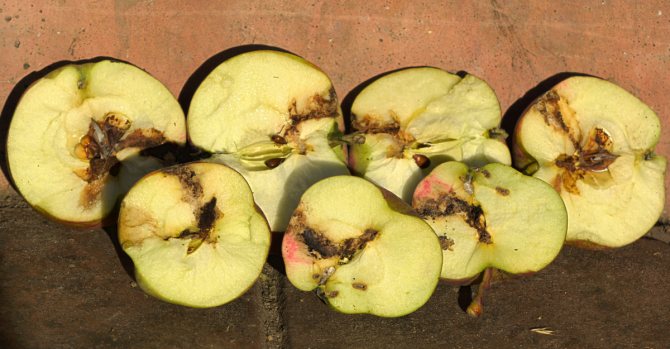

Folk recipes for fighting the moth
Tobacco broth
To prepare this product, you will need 0.5 kg of dry tobacco. The substance is infused in a bucket of water for two days. After this time, the infusion is boiled, then after cooling, add another 10 liters of water. Before use, 250 grams of soap is diluted in the finished broth. Processing should be carried out during the period of mass appearance of caterpillars.
Important! The tobacco solution is quite toxic to humans. It is important to use special protective equipment when processing this agent, as well as when processing insecticides.
Wormwood decoction
To prepare the broth in 1 liter of water, 1 kg of wormwood is boiled for 20 minutes. After the broth has cooled, 10 liters of water are added to it. The product is ready for use.
Red pepper decoction
To prepare it, you need 0.5 kg of red pepper pods, pour 2 liters of water. The pepper mass is boiled for about 2 hours with the lid closed. Then the broth is insisted for another two days.
Then the composition is filtered. Each half-liter of the product is diluted with one bucket of water and 50 g is added to it. Soaps. The remaining product can be stored until the next processing if placed in a closed container.
Tomato infusion
Tomato infusion has proven to be excellent deterrent properties against the moth. To prepare this product, you will need to grind 4 kg of tomatoes. It can be foliage, stems, green tomatoes. The chopped grass is poured with 10 liters of water and put on fire. The green mass is boiled for 30 minutes. Then the broth is filtered. Every 2 liters of the finished broth is diluted with 10 liters of water and 50 g is added. soap. The resulting composition is carried out 2-3 treatments per season.


Tomato infusion
Preventive actions
It's not a secret for anyone that the best option for saving from pests will be, if they are not allowed into the garden at all. Simple measures that will simply prevent the spread of the pest population further will become quite effective solutions:
- If you find areas with peeled bark, you should remove it, as this is an additional cover for the caterpillars for the winter.
- Digging the soil in the root zone, as well as loosening the soil so that the hidden cocoons die during the first frost.
- Removal of damaged branches and shoots.
- When hollows and cracks appear on the trees, they should be properly repaired.
- Carrying out regular inspections of the crown and foliage, if damaged areas are found, the leaves and shoots should be removed.
- Preventive treatment of apple trees after flowering from the moth with biological or chemical preparations.
- Damaged fruits that fall should be collected and destroyed regularly.
- To catch caterpillars, trapping belts are placed on the trunks, which will help to destroy many crawling insects.
As practice shows, an effective way to combat the stalk is the artificial launch of hymenoptera insects - trichogramma - into the garden. They parasitize in moth eggs, which helps to significantly reduce crop spoilage (approximately threefold). This insect is bred in laboratories and when fighting the moth is most often used in large production areas. Trichograms are produced in two stages: at the very beginning of oviposition and during mass oviposition.


Hymenoptera insects
Questions From Readers
There are a number of nuances that gardeners have a misconception about.
The starlings on the apple tree feed on caterpillars
This is partly true, but only vaguely. Only some species of titmice are massively destroyed by the moth. Moreover, they do this only during the period of time when the worms have crawled out of the fruits and until the moment when they choose their wintering place.
Flowers protecting the apple tree from worms
In bio-agriculture, it is believed that some plant species exude an aroma that is harmful to insects. In practice, this has not been confirmed. They may not be happy with the smell emanating from certain plant species, but the feeling of hunger is not taken away from them.
What are the danger to the tree and the crop
The gluttonous pest quickly infects whole hectares of apple orchards. If they are not destroyed, then you can lose the crop altogether. Insects make many moves in the fruit, thereby spoiling the structure and aesthetic appearance. Damaged fruits are not stored.
Prevention of the appearance of the apple moth
- It is necessary to clean the bark of trees twice a year (in spring and autumn) and remove the cocoons of butterflies that winter there;
- In order to remove fruits that have been affected by the moth, the trees are periodically shaken. All fallen apples must be picked and carried as far away from fruit trees as possible;
- A flower bed should be set up around the apple trees to attract various insects that feed on pests;
- The fruit moth does not like the smell of tomatoes, so they will not become superfluous near your garden;
- Caterpillars always leave fallen apples and return to the tree in search of new food. It is at this moment that they can be caught. Cunning summer residents use sticky tape for catching flies for this. It is simply wrapped around the trunk. Do not forget that different insects will stick to this tape, so it needs to be updated regularly;
- Adult butterflies are lured with apple syrup, which is prepared according to the following recipe: for 2 liters of water, you will need 100 grams of dried apples. Boil them for thirty minutes and add yeast and sugar to the syrup. During the fermentation process, this compote is of great interest to butterflies, which costs them their lives;

